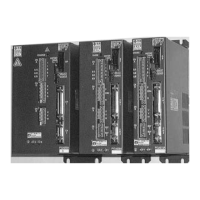9. SPECIFICATIONS
9-28
(3) Typical monitor applications
This section explain typical applications of the velocity and current monitor.
Speed and current measurement
When connecting a measuring instrument to the velocity or current feedback monitor, use a
both-swing type CD voltmeter and connect it as in Fig. 9-12 (5).
In this case, use a shielded wire and make the wiring as short as possible.
Fig. 9-12 (5) Typical Connection of Monitor and Measuring Instrument
• Current feedback monitor output (CN1 - 16)
±0.5 V±20%/rated armature current.
• Velocity feedback monitor output (CN1 - 15)
±0.5 V±20%/1000 min
-
1
.
• The maximum monitor output voltage is ±3 V.
1 When the contents of the monitor output are changed using the remote operator or PC
interface, the contents of CN1-15 and CN1-16 are also changed.
So, When the above use is employed for CN1-15 and CN1-16, change the contents
carefully so as not to damage the measuring instrument.
2 For measuring the velocity/current monitor, use a DC voltmeter (both-swing type) of
10 kΩ or more.
3 When the control power is turned on or off, the monitor output becomes unfixed,
outputting about ±5.5 V.
When any measuring instrument is connected, be careful not to damage it.
( 2)
Tachometer
min
−
1
A
Servo Amplifier side

